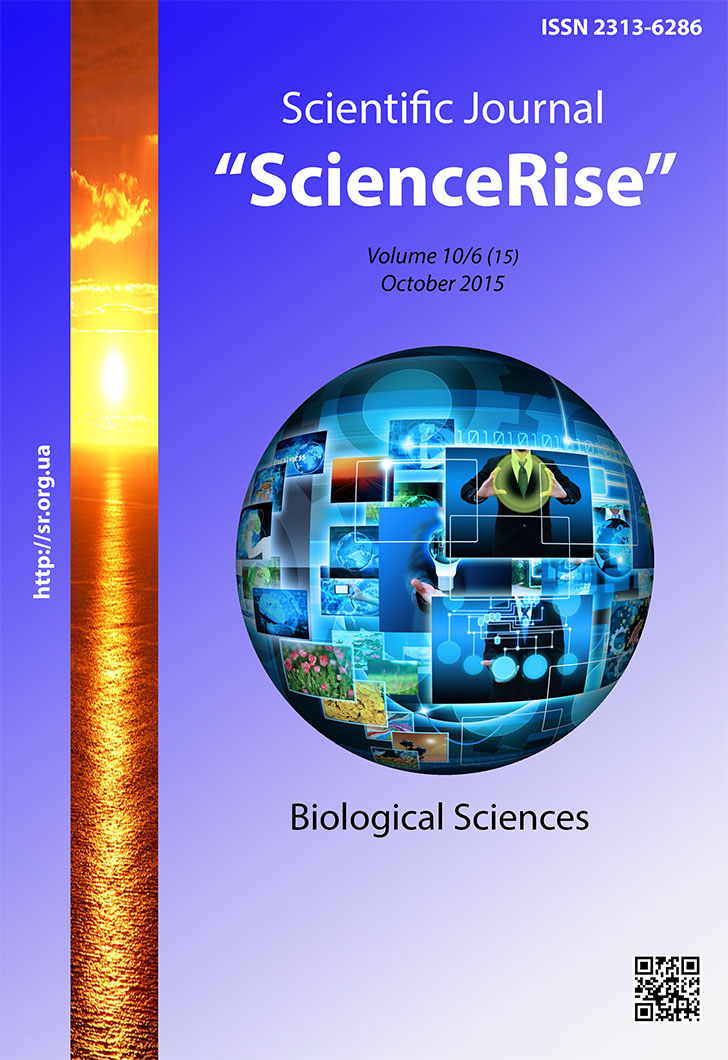Аналіз продуктивності біотехнологічного отримання водню за використання мікроорганізмів з різними типами метаболізму, перспективні напрямки подальших досліджень
DOI :
https://doi.org/10.15587/2313-8416.2015.52116Mots-clés :
біоводень, темнове бродіння, пурпурні бактерії, гідрогенази, мікробний паливний елемент, екзоелектрогениRésumé
У статті проаналізовано основні біотехнологічні методи отримання водню, а саме: біофотоліз води з використанням водоростей або ціанобактерій, темнове бродіння, а також отримання водню у мікробних паливних елементах. Розглянуто біохімічні особливості виробництва водню мікроорганізмами з різними типами метаболізму. Визначено недоліки кожного з методів та перспективні напрямки подальших досліджень
Références
Lovley, D. R. (2006). Bug juice: harvesting electricity with microorganisms. Nature Reviews Microbiology, 4 (7), 497–508. doi: 10.1038/nrmicro1442
Markov, S. A., Weaver, P. F. (2007). Bioreactors for H2 Production by Purple Nonsulfur Bacteria. Applied Biochemistry and Biotechnology, 145 (1-3), 79–86. doi: 10.1007/s12010-007-8032-z
Holub, N., Shchurska, K., Trotzenko, M. (2014). Anaerobne ochyshchennia stichnykh vod pyvzavodiv z odnochasnym oderzhanniam vodniu [Simultaneous anaerobic wastewater treatment and hydrogen production]. Journal of Water Chemistry. and Technology, 2, 163–176.
Prytula, I., Tashyrev, O. (2012). Usovershenstvovanie metoda vydeleniia vodorobrazuiushchikh bakteriy roda Clostridium [Improvement of the isolation method of hydrogen, which is formed by bacteria of genus Clostridium] Microbiology Journal, 74 (6), 58–64.
Shchurska, K., Kuzminskii, Ye. (2011). Sposoby produkuvannia biovodniu [Methods of hydrogen production]. Scientific news “KPI”, 3, 105–114.
Chong, M.-L., Sabaratnam, V., Shirai, Y., Hassan, M. A. (2009). Biohydrogen production from biomass and industrial wastes by dark fermentation. International Journal of Hydrogen Energy, 34 (8), 3277–3287. doi: 10.1016/j.ijhydene.2009.02.010
Ntaikou, I., Antonopoulou, G., Lyberatos, G. (2010). Biohydrogen Production from Biomass and Wastes via Dark Fermentation: A Review. Waste and Biomass Valorization, 1 (1), 21–39. doi: 10.1007/s12649-009-9001-2
Venkata, M. S. (2009). Harnessing of biohydrogen from wastewater treatment using mixed fermentative consortia: Process evaluation towards optimization. International Journal of Hydrogen Energy, 34 (17), 7460–7474. doi: 10.1016/j.ijhydene.2009.05.062
Reungsang, A., Saripan, A. F. (2013). Biohydrogen production by Thermoanaerobacterium thermosaccharolyticum KKU-ED1: Culture conditions optimization using mixed xylose/arabinose as substrate. Electronic Journal of Biotechnology, 16 (1). doi: 10.2225/vol16-issue1-fulltext-1
Chen, C.-Y., Yang, M.-H., Yeh, K.-L., Liu, C.-H., Chang, J.-S. (2008). Biohydrogen production using sequential two-stage dark and photo fermentation processes. International Journal of Hydrogen Energy, 33 (18), 4755–4762. doi: 10.1016/j.ijhydene.2008.06.055
De Amorim, E. L. C., Sader, L. T., Silva, E. L. (2012). Effect of Substrate Concentration on Dark Fermentation Hydrogen Production Using an Anaerobic Fluidized Bed Reactor. Applied Biochemistry and Biotechnology, 166 (5), 1248–1263. doi: 10.1007/s12010-011-9511-9
Hay, J. X. W., Wu, T. Y., Juan, J. C., Md. Jahim, J. (2013). Biohydrogen production through photo fermentation or dark fermentation using waste as a substrate: Overview, economics, and future prospects of hydrogen usage. Biofuels, Bioproducts and Biorefining, 7 (3), 334–352. doi: 10.1002/bbb.1403
Seifert, K., Thiel, M., Wicher, E., Wodarczak, M., Laniecki, M. (2012). Microbiological Methods of Hydrogen Generation. Faculty of Chemistry, A. Mickiewicz University, Poznań, Poland. 225–250. doi: 10.5772/33563
Oh, Y.-K., Kim, Y.-J., Park, J.-Y., Lee, T. H., Kim, M.-S., Park, S. (2005). Biohydrogen production from carbon monoxide and water byRhodopseudomonas palustris P4. Biotechnology and Bioprocess Engineering, 10 (3), 270–274. doi: 10.1007/bf02932024
Bothe, H., Winkelmann, S., Boison, G. (2008). Maximizing Hydrogen Production by Cyanobacteria. Zeitschrift Für Naturforschung C, 63 (3-4), 226–232. doi: 10.1515/znc-2008-3-412
Natural'noe jelektrichestvo: fotosintez – delo budushhego (2006). Populjarnaja mehanika. Available at: http://www.popmech.ru/article/670-naturalnoe-elektrichestvo//
Chongcharoenthaweesuk, P., Jiangdong, Z., Mavituna, F. (2011). Metabolic flux balance analysis for biological hydrogen production by purple non-sulfur bacteria. IACSIT Press, Singapoore, 9.
Balashev, K. (1998). Fotocataliticheskoe preobrazovanie solnechnoy energii. [Photocatalytic conversation of sun energy]. International Soros Science Education, 8, 58–64. Available at: http://window.edu.ru/resource/259/21259/files/9808_058.pdf
Rubin, A. (2003). Reguliatzia pervichnyh protzessov photosinteza [Regulation of primary processes of photosynthesis]. Successes of biochemistry, 43, 225–265. Available at: http://www.inbi.ras.ru/ubkh/43/rubin.pdf
Nikandrov, V. (2000). Neorganicheskiie poluprovodniki v biologicheskih I biochimicheskih sistemah: biosintez, svoystva i fotohimicheskaia aktivnost [Inorganic semiconductiors in biological and biochemical systems: biosynthesis, characteristics and photocgemical activity]. Successes of biochemistry, 40, 357–596. Available at: http://www.inbi.ras.ru/ubkh/40/nikandrov.pdf
Logan, B. E. (2005). Simultaneous wastewater treatment and biological electricity generation. Water Science & Technology, 52 (1-2), 31–37.
Ahn, Y., Logan, B. E. (2010). Effectiveness of domestic wastewater treatment using microbial fuel cells at ambient and mesophilic temperatures. Bioresource Technology, 101 (2), 469–475. doi: 10.1016/j.biortech.2009.07.039
Dalvi, A. D., Mohandas, N., Shinde, O. A., Kininge, P. T. (2011). Microbial fuel cell for production of bioelectricity from whey and biological waste treatment. International journal of advanced biotechnology and research, 2 (2), 263–268.
Mathura, A. K., Singh, D. (2007). Microbial fuel cells: A promising technology for waste water treatment and power generation. Environ. Sci. Technol., 35, 3057–3063.
Zielke, E. A. (2005). Design of a single chamber microbial fuel cell. Microbial Fuel Cell technology, 35. Available at: http://www.engr.psu.edu/ce/enve/logan/bioenergy/pdf/engr_499_final_zielke.pdf
Téléchargements
Publié-e
Numéro
Rubrique
Licence
(c) Tous droits réservés Людмила Сергіївна Зубченко, Євген Васильович Кузьмінський 2015

Cette œuvre est sous licence Creative Commons Attribution 4.0 International.
Our journal abides by the Creative Commons CC BY copyright rights and permissions for open access journals.
Authors, who are published in this journal, agree to the following conditions:
1. The authors reserve the right to authorship of the work and pass the first publication right of this work to the journal under the terms of a Creative Commons CC BY, which allows others to freely distribute the published research with the obligatory reference to the authors of the original work and the first publication of the work in this journal.
2. The authors have the right to conclude separate supplement agreements that relate to non-exclusive work distribution in the form in which it has been published by the journal (for example, to upload the work to the online storage of the journal or publish it as part of a monograph), provided that the reference to the first publication of the work in this journal is included.

